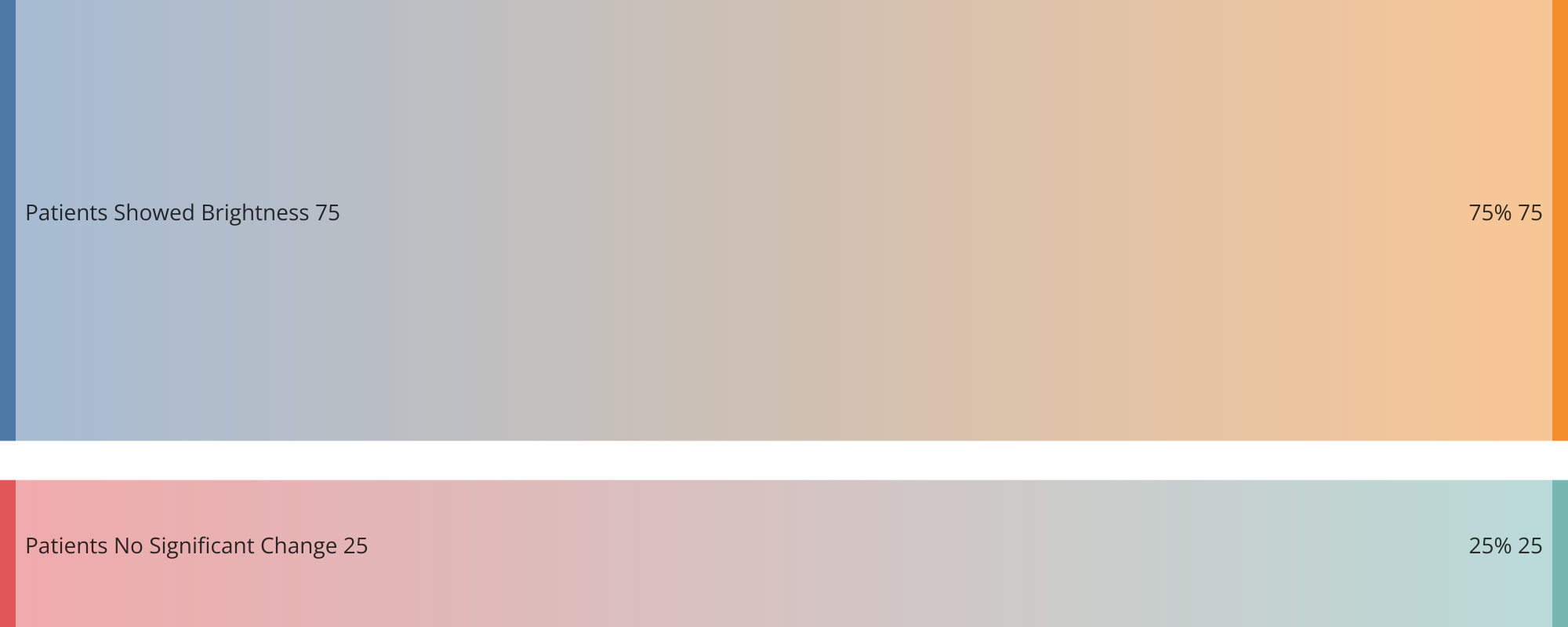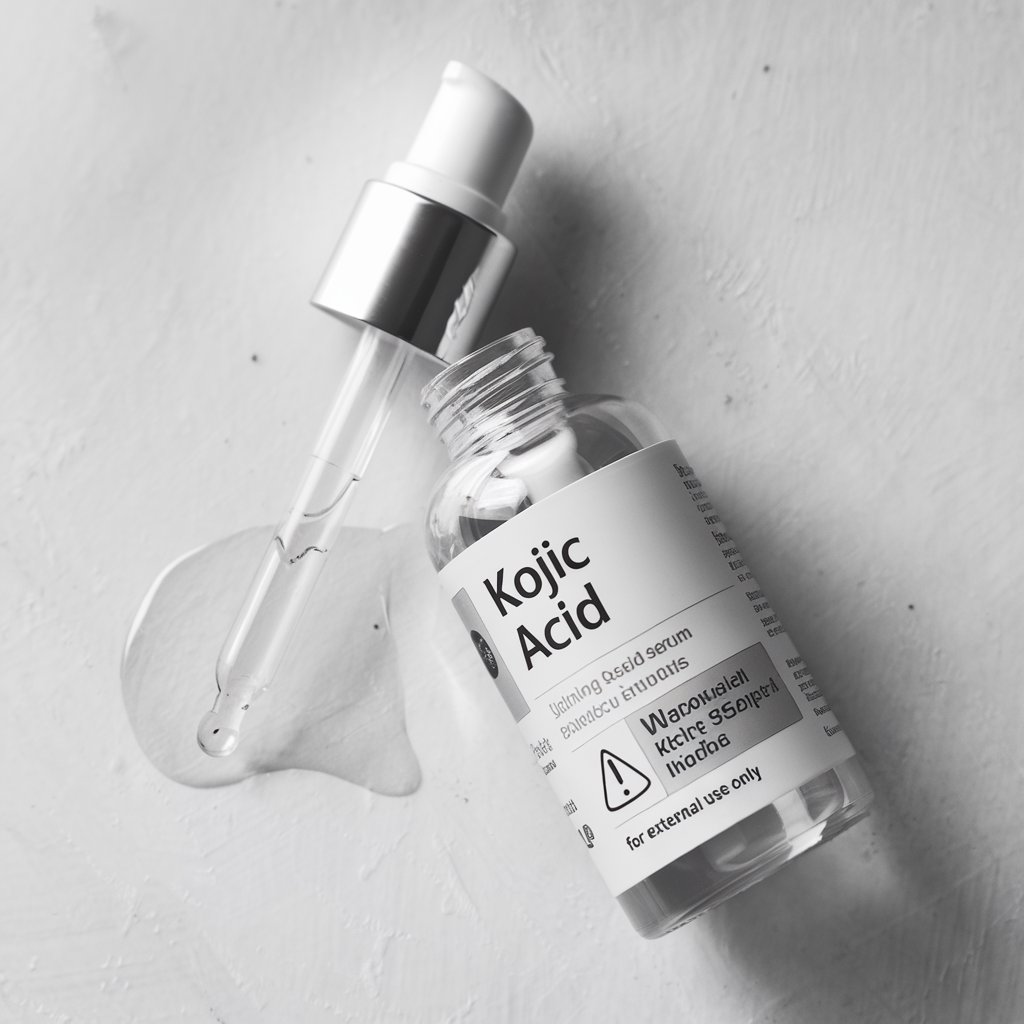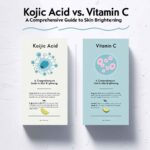- Kojic acid lightens skin by inhibiting tyrosinase, an enzyme responsible for melanin production.
-
Kojic acid is effective in treating hyperpigmentation, age spots, melasma, and acne scars.
-
Clinical studies show kojic acid’s ability to brighten and even skin tone.
-
Kojic acid is a gentler alternative to hydroquinone and complements other brightening ingredients.
Kojic acid is a well-known name in the world of organic skincare. It’s often hailed for its ability to brighten the skin, but how exactly does it work? What’s the science behind its effects? If you’re curious about how to safely incorporate this ingredient into your skincare routine, this article will help you out.
How Kojic Acid Lightens Skin: The Science
To understand how kojic acid lightens skin, we first need to look at melanin. Melanin is the pigment responsible for the color of your skin, hair, and eyes. Your body produces melanin through an enzyme called tyrosinase. Here’s where kojic acid steps in: it blocks tyrosinase, which reduces melanin production. The result? Lighter, more even-toned skin over time.
Skin Lightening: How Long Does Kojic Acid Take to Work?
Inhibition of Tyrosinase: The Core of Kojic Acid’s Action
Tyrosinase is an enzyme your skin needs to produce melanin. When kojic acid inhibits tyrosinase, it slows down or stops melanin production. Without melanin, dark spots, whether from sun exposure, aging, or acne, become less noticeable. Over time, this inhibition lightens areas of hyperpigmentation, such as:
-
Age spots
-
Dark spots caused by acne
-
Melasma
-
Uneven skin tone from sun damage
These effects are why kojic acid is a common ingredient in brightening serums and creams.
Antioxidant Properties
Kojic acid also has antioxidant properties, which means it protects your skin from oxidative stress caused by free radicals. Free radicals are unstable molecules that contribute to premature aging and skin pigmentation issues. When used consistently, kojic acid helps to neutralize these free radicals, which has a two-fold benefit. first, it keeps your skin looking younger and secondly, it addressing dark spots.
Proven Results: Hyperspectral Imaging Studies on Kojic Acid
The effectiveness of kojic acid isn’t just theoretical. Researchers have used advanced technology, like hyperspectral imaging, to assess how well it works. In one particular study involving 12 patients with post-acne hyperpigmentation, 75% of participants showed increased skin brightness after using a 3% kojic acid preparation. The participants also had more uniform skin tone and reduced contrast between dark and light areas on their skin. These findings confirm that kojic acid can genuinely improve skin homogeneity.

Kojic Acid’s Clinical Benefits
Kojic acid has made its way into a wide variety of skincare products, from serums to soaps. But what exactly are its benefits in these formulations?
Reduction of Hyperpigmentation
For those struggling with uneven skin tone or dark patches, kojic acid may provide a solution. It’s particularly effective in treating hyperpigmentation from sun exposure, aging, or hormonal imbalances.
Anti-Aging Effects
By lightening age spots and promoting a more even skin tone, kojic acid can help give the appearance of younger, healthier skin.
Antimicrobial Properties
Some studies suggest that kojic acid also has antifungal and antibacterial properties. While this isn’t its primary use in skincare, these properties may help prevent acne and other minor skin infections.
Kojic Acid and Acne: A Surprising Connection
Acne can leave behind stubborn dark marks, also known as post-inflammatory hyperpigmentation. Kojic acid’s ability to reduce melanin production makes it a great option for fading these acne scars. Additionally, its potential antimicrobial effects can help prevent future breakouts. While more research is needed to fully confirm these antimicrobial benefits, its impact on post-acne marks is clear.
How to Use Kojic Acid Safely
While kojic acid is generally safe, it’s crucial to use it properly. Most skincare products contain kojic acid concentrations between 1% and 4%. If you’re new to this ingredient, starting with a lower concentration and patch-testing is always a good idea.
But, there’s a catch: kojic acid can make your skin more sensitive to sunlight. This means you should never skip sunscreen when using products with kojic acid. If you don’t protect your skin, the sun can undo the brightening effects and even cause new dark spots.
Side Effects to Watch Out For
Though kojic acid is considered safe, some individuals may experience side effects like:
-
Increased sun sensitivity
-
Irritation, especially if used in high concentrations
If you notice any irritation, reduce your usage or switch to a lower-concentration product. Always consult with a dermatologist if you’re unsure about how kojic acid will interact with your skin.
Kojic Acid vs. Other Brightening Ingredients
There are many skin-brightening ingredients, but how does kojic acid compare? Let’s compare it to a few popular ones:
Kojic Acid vs. Hydroquinone
Hydroquinone is often considered the gold standard for treating hyperpigmentation, but it may cause side effects, such as skin irritation and ochronosis (a blue-black discoloration of the skin). Kojic acid, on the other hand, is a gentler alternative and is widely used in organic skincare.
Kojic Acid vs. Vitamin C
Vitamin C is another popular brightening ingredient, known for its antioxidant properties. While both are effective in reducing pigmentation, kojic acid works specifically by inhibiting melanin production, whereas vitamin C brightens skin through its overall antioxidant benefits.
Kojic Acid vs. Niacinamide
Niacinamide is a form of vitamin B3 that helps with skin brightening and strengthening the skin barrier. It’s a gentler option, and combining it with kojic acid can provide even better results for skin brightening.
Who Should Use Kojic Acid?
If you’re dealing with hyperpigmentation, dark spots, or even mild cases of melasma, kojic acid might be a great option for you. It’s suitable for most skin types, but if you have sensitive skin, you’ll want to start slow and see how your skin reacts. Pairing it with other soothing ingredients, like aloe vera or hyaluronic acid, can minimize the risk of irritation.
For those with acne scars, kojic acid offers the dual benefit of fading marks and potentially reducing future breakouts, thanks to its antimicrobial properties.
Incorporating Kojic Acid into Your Routine
If you’re ready to try kojic acid, here’s how you can safely incorporate it into your skincare routine:
-
Start Slowly: Use a product with a lower concentration (1% to 2%) if you’re new to kojic acid.
-
Apply Once a Day: Begin by using it once a day, preferably in the evening.
-
Always Wear Sunscreen: Since kojic acid can increase your skin’s sensitivity to the sun, applying SPF daily is a must.
-
Moisturize: Kojic acid can sometimes cause dryness or irritation, so it’s important to keep your skin hydrated with a gentle, non-comedogenic moisturizer.
How long does it take for kojic acid to lighten skin?
Kojic acid requires 1 to 2 months of consistent topical use before you notice noticeable improvements in skin lightening. According to various sources, the timeline for results can vary based on individual skin types and the severity of hyperpigmentation. Some users may start to see results as early as 4 to 6 weeks of consistent application, but full effects often take longer. For optimal results, it is recommended to use kojic acid continuously for up to 90 days, after which you should assess the progress.
Final Thoughts
Kojic acid offers a natural, science-backed solution for those looking to brighten their skin and reduce hyperpigmentation. Whether you’re dealing with acne scars, age spots, or just looking to achieve a more even skin tone, this ingredient has a lot to offer. However, as with any skincare product, using it safely and consistently is key to seeing the best results.
Sources:
- https://gethealthyskin.com/ingredients/kojic-acid
- https://www.ncbi.nlm.nih.gov/pmc/articles/PMC7147621/
- https://www.ncbi.nlm.nih.gov/pmc/articles/PMC7147621/
- https://www.ncbi.nlm.nih.gov/pmc/articles/PMC10094916/
- https://www.ncbi.nlm.nih.gov/pmc/articles/PMC10094916/

I’m a devoted organic skincare enthusiast, passionate about the natural, wholesome goodness that organic products bring to our skin.
Organic skincare isn’t just a hobby for me—it’s a lifestyle. Every product I use, recommend, and write about has been carefully chosen for its purity and effectiveness. Everything I write about is backed by scientific studies, dermatologists’ opinions, and user experiences.
I also excel at tackling skincare challenges with innovative, organic solutions.

